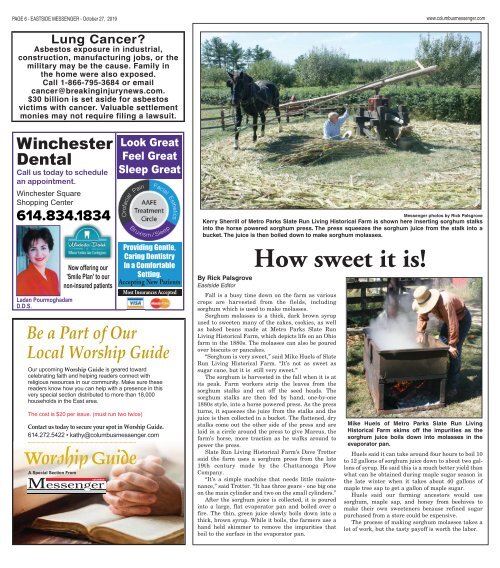Eastside Messenger - October 27th, 2019
You also want an ePaper? Increase the reach of your titles
YUMPU automatically turns print PDFs into web optimized ePapers that Google loves.
PAGE 6 - EASTSIDE MESSENGER - <strong>October</strong> 27, <strong>2019</strong><br />
www.columbusmessenger.com<br />
Lung Cancer?<br />
Asbestos exposure in industrial,<br />
construction, manufacturing jobs, or the<br />
military may be the cause. Family in<br />
the home were also exposed.<br />
Call 1-866-795-3684 or email<br />
cancer@breakinginjurynews.com.<br />
$30 billion is set aside for asbestos<br />
victims with cancer. Valuable settlement<br />
monies may not require filing a lawsuit.<br />
Winchester<br />
Dental<br />
Call us today to schedule<br />
an appointment.<br />
Winchester Square<br />
Shopping Center<br />
614.834.1834<br />
Ladan Pourmoghadam<br />
D.D.S.<br />
Be a Part of Our<br />
Local Worship Guide<br />
Our upcoming Worship Guide is geared toward<br />
celebrating faith and helping readers connect with<br />
religious resources in our community. Make sure these<br />
readers know how you can help with a presence in this<br />
very special section distributed to more than 18,000<br />
households in the East area.<br />
The cost is $20 per issue. (must run two twice)<br />
Contact us today to secure your spot in Worship Guide.<br />
614.272.5422 • kathy@columbusmessenger.com<br />
A Special Section From<br />
Now offering our<br />
'Smile Plan' to our<br />
non-insured patients<br />
columbus<br />
Look Great<br />
Feel Great<br />
Sleep Great<br />
Providing Gentle,<br />
Caring Dentistry<br />
In a Comfortable<br />
Setting.<br />
Accepting New Patients<br />
Most Insurances Accepted<br />
<strong>Messenger</strong> photos by Rick Palsgrove<br />
Kerry Sherrill of Metro Parks Slate Run Living Historical Farm is shown here inserting sorghum stalks<br />
into the horse powered sorghum press. The press squeezes the sorghum juice from the stalk into a<br />
bucket. The juice is then boiled down to make sorghum molasses.<br />
How sweet it is!<br />
By Rick Palsgrove<br />
<strong>Eastside</strong> Editor<br />
Fall is a busy time down on the farm as various<br />
crops are harvested from the fields, including<br />
sorghum which is used to make molasses.<br />
Sorghum molasses is a thick, dark brown syrup<br />
used to sweeten many of the cakes, cookies, as well<br />
as baked beans made at Metro Parks Slate Run<br />
Living Historical Farm, which depicts life on an Ohio<br />
farm in the 1880s. The molasses can also be poured<br />
over biscuits or pancakes.<br />
“Sorghum is very sweet,” said Mike Huels of Slate<br />
Run Living Historical Farm. “It’s not as sweet as<br />
sugar cane, but it is still very sweet.”<br />
The sorghum is harvested in the fall when it is at<br />
its peak. Farm workers strip the leaves from the<br />
sorghum stalks and cut off the seed heads. The<br />
sorghum stalks are then fed by hand, one-by-one<br />
1880s style, into a horse powered press. As the press<br />
turns, it squeezes the juice from the stalks and the<br />
juice is then collected in a bucket. The flattened, dry<br />
stalks come out the other side of the press and are<br />
laid in a circle around the press to give Marcus, the<br />
farm’s horse, more traction as he walks around to<br />
power the press.<br />
Slate Run Living Historical Farm’s Dave Trotter<br />
said the farm uses a sorghum press from the late<br />
19th century made by the Chattanooga Plow<br />
Company.<br />
“It’s a simple machine that needs little maintenance,”<br />
said Trotter. “It has three gears - one big one<br />
on the main cylinder and two on the small cylinders.”<br />
After the sorghum juice is collected, it is poured<br />
into a large, flat evaporator pan and boiled over a<br />
fire. The thin, green juice slowly boils down into a<br />
thick, brown syrup. While it boils, the farmers use a<br />
hand held skimmer to remove the impurities that<br />
boil to the surface in the evaporator pan.<br />
Mike Huels of Metro Parks Slate Run Living<br />
Historical Farm skims off the impurities as the<br />
sorghum juice boils down into molasses in the<br />
evaporator pan.<br />
Huels said it can take around four hours to boil 10<br />
to 12 gallons of sorghum juice down to about two gallons<br />
of syrup. He said this is a much better yield than<br />
what can be obtained during maple sugar season in<br />
the late winter when it takes about 40 gallons of<br />
maple tree sap to get a gallon of maple sugar.<br />
Huels said our farming ancestors would use<br />
sorghum, maple sap, and honey from beehives to<br />
make their own sweeteners because refined sugar<br />
purchased from a store could be expensive.<br />
The process of making sorghum molasses takes a<br />
lot of work, but the tasty payoff is worth the labor.


















